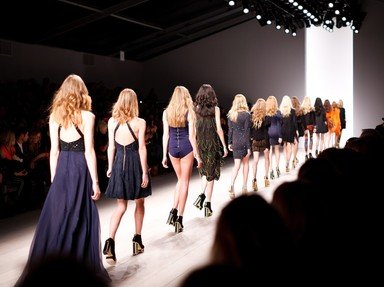Quiz Answer Key and Fun Facts
1. 1950: Ah, the dress that ran straight from the arms to the upper thighs, before continuing down either straight or with a slight flare. It was a wonderful dress. You could belt it or not, as well as put that belt high or low, as you wished, depending on what part of your body you wished to emphasize or de-emphasize. For those with less than a waspish waist it was a wonderful garment. What was this dress known as?
2. 1951: The year of the little waist. To magnify that asset, the skirts were made big and full, and often were stiffened with interlinings. Another way of ensuring the skirt stayed "big" was to wear a _____________ under it?
3. 1952: This was the year for a type of skirt that the new "miracle fabrics" helped to bring into style since they could hold a form, were often washable, and wrinkled very little. These skirt types could begin at the waist or at the hip. What were these skirts?
4. 1953: This year a certain French fashion designer led sway and went against the mainstream by raising the hemlines from about 13" above the floor to as much as 17" above the floor. What was this designer's last name?
5. 1954: An industry which had been in rather a depression, at least in the US, for a number of years began making a comeback in 1954 in women's clothing, in trimming, and other usage. It made women feel more feminine, too. What industry was that?
6. 1955: This was the year of a new emphasis in women's clothing, a new "look". It permeated the designs for coats, dresses, jackets and even evening wraps. Colorful and made from rich looking and feeling fabrics, what was the name of this "look"?
7. 1956: A year that brought a romantic look to clothes, using chiffon, satin, thin silk and other clingy fabrics. A play on Broadway that year, later made into a block-buster movie, was a major influence on clothes style, bringing the look and feel of the late Edwardian era, right before World War I. Cecil Beaton designed the clothes for the play, with longer, narrower skirts, wrapped coats and many large, frothy, hats. What was the name of that play?
8. 1957: This was the year of experimentation by the designers, except for one. This designer had come out in the 1920s with a two-piece, casual, outfit, usually piped in a contrasting color, that became as popular in 1957 as it was in its heyday. What was this designer's name?
9. 1958: Fur continued its popularity, both in trim, hats, jackets and coats. Intense color, from 1955 continued on. New forms of the chemise, so popular in 1950, debuted. Saint-Laurent, Dior's successor, brought out a style of dress that men detested, but the young ladies and women liked. It didn't last very long in popularity, but while it was there everyone had to have one. What style of dress was this?
10. 1959: Fur was still coming on strong, particularly large Fox fur collars on coats. The chemise was still evolving to the point of having a partially defined waist. The Chanel suit was still popular and was now worn for evening wear in brocade and damask, too. But the outfit that was "Americanizing" Europe was a dress that even Mamie Eisenhower had been seen in, as well as a great deal of everyday American women. Of what style of dress was this?
Source: Author
habitsowner
This quiz was reviewed by FunTrivia editor
kyleisalive before going online.
Any errors found in FunTrivia content are routinely corrected through our feedback system.

